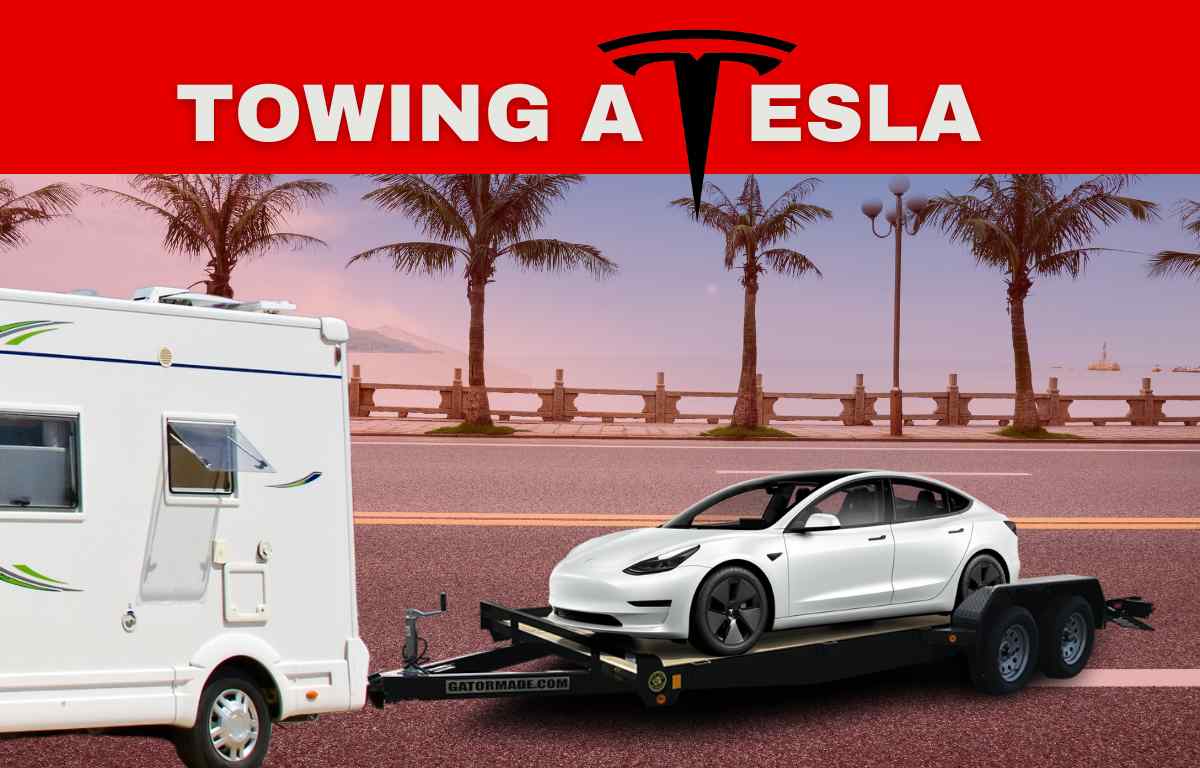
If you decide to hit the road in your motorhome and plan to tow your vehicle, congratulations. This can be exciting until you start researching options for your electric vehicle. Unlink traditional Internal Combustion Engine (ICE) cars, most electric vehicles like a Tesla have some pretty significant limitations for towing it. In short, they can’t be flat towed or have the wheels spinning while in transit. This leaves Tesla and other EV owners only one option: towing it on a flatbed trailer with a Class A or Class C motorhome.
While this can be frustrating for taking your car on your next RV trip, there’s a good reason why you can simply flat tow or use a dolly for an electric car. This has to do with the way electric vehicles are designed. Unlike a typical gas vehicle and regular transmission, which you can put in a neutral position to disengage, electric vehicles don’t have a transmission. Instead, power to the wheels is controlled by electric current instead of gears used in traditional vehicles.
This feature is what creates the instant torque that Tesla owners love. It is also one of the reasons they tend to be more reliable. When the wheels spin from rolling, and not by the electric motor’s power, they are still connected to the systems that allow the car to drive, and doing so can cause significant damage to the vehicle. The best method is always to use a flatbed trailer.
In a Tesla, all four wheels are powered (AWD), so even towing it on a two-wheel dolly is out of the question. In addition, to safely tow a Tesla and most other electric vehicles, all four wheels cannot spin.
How Can You Tow Your Tesla
As mentioned above, the wheels of your Tesla must be entirely off the ground and not spin during transport. So, when writing this article, the only towing option is a flatbed trailer or car transporter. While this may be cumbersome, the good news is that an option is available if you want to bring your Tesla along on your camping adventures. Regardless of what trailer you choose, check your RV’s towing capacity and ensure it has a proper tow hitch installed for the trailer.
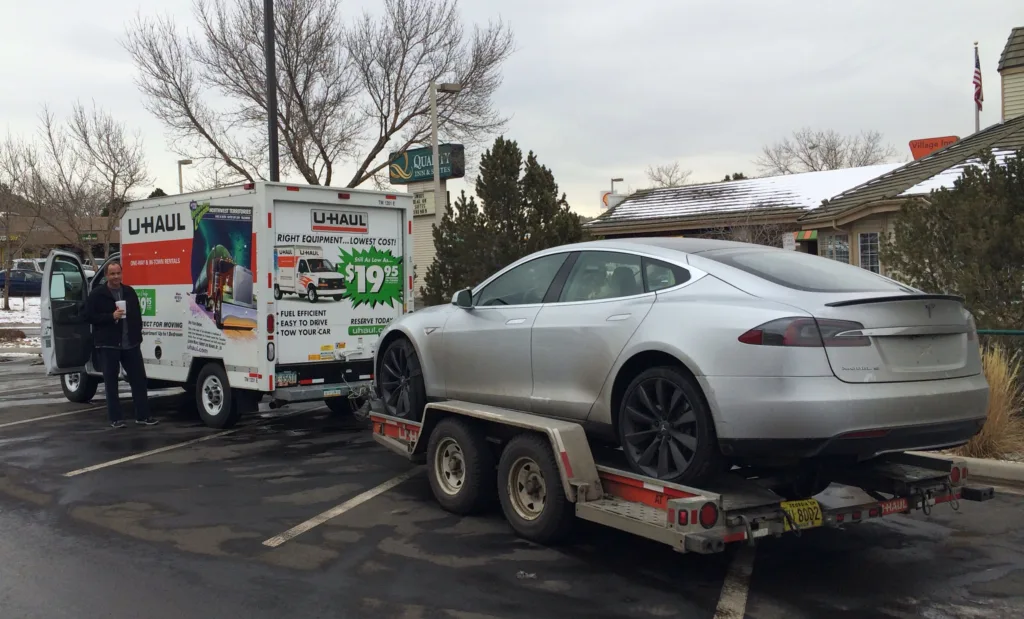
When towing a Tesla, you must take extra precautions to ensure you don’t cause serious damage to the vehicle. As mentioned above, a flatbed trailer is the only viable way to tow it. Below are the general steps for towing your Tesla:
TOWING A TESLA WITH AN RV
- Read the owner’s manual: Tesla’s a technologically advanced car, and what may seem familiar in a regular vehicle may be different in your Tesla. So first, get familiar with your specific car and follow the towing steps in your manual. Next, review the owner’s manual for your specific Tesla model to understand if towing is recommended and any specific instructions or limitations provided by the manufacturer. Tesla has a built-in guide to get you started:
- To activate, you need to press and hold the brake pedal, then on the touchscreen, touch Controls, then Service and Towing. The touchscreen displays a message that guides you through the process.
- Choose a flatbed trailer: As you may already know, Tesla vehicles are not designed for flat towing (all four wheels on the ground) due to their drivetrain and regenerative braking system. Therefore, you will need a flatbed trailer when towing it behind your RV.
- Engage the dedicated Transport Mode: Tesla vehicles have a “Tow Mode” feature that must be enabled before towing. This mode disengages the parking brake and optimizes the vehicle’s systems for towing.
- Prepare the Tesla for towing:
- Charge the battery: Ensure the Tesla’s battery is adequately charged before towing. This will allow for any necessary system operations during the towing process.
- Disable Autopilot and Summon features: If your Tesla is equipped with Autopilot or Summon features, disable them before towing.
- Engage Park mode: Put the vehicle in Park mode, ensuring the parking brake is disengaged when Tow Mode is activated.
- Load the Tesla onto a flatbed trailer: Carefully load the Tesla onto a flatbed trailer or car carrier. Ensure the vehicle is centered correctly and secured using appropriate straps or restraints for each tire. If you need to pull the car onto the trailer, use the tow eye on the front driver’s side. The tow eye key should be under the front trunk carpet.
- Secure the vehicle to the trailer: Do not tie into the frame. Instead, use tire tie-down straps to keep the vehicle from moving.
- Double-check the Tesla: Before towing, verify that the Tesla’s doors are securely closed, windows are rolled up, the vehicle is securely fastened to the trailer or car carrier, and the Tesla is set to carrier mode.
- Transport the Tesla: The towing service will transport the Tesla to the desired location, taking care to drive cautiously and following local regulations.
Telsa provides a lot of information about safely towing your vehicle. While most information is geared toward roadside towing service, much of what they say allies most towing needs. They offer their own Tesla Roadside Assistance to ensure the tow truck driver is aware of potential hazards with improperly towing the vehicle.
How do you tow a non-EV Car?
Typically, with a non-EV internal combustion engine (ICE) car, motorhomes trailer a vehicle by using a tow bar or a tow dolly. They are smaller and lighter than a flatbed trailer. The method you choose depends on the type of motorhome you have and the vehicle you tow. The simple steps for towing a regular vehicle behind a motorhome include::
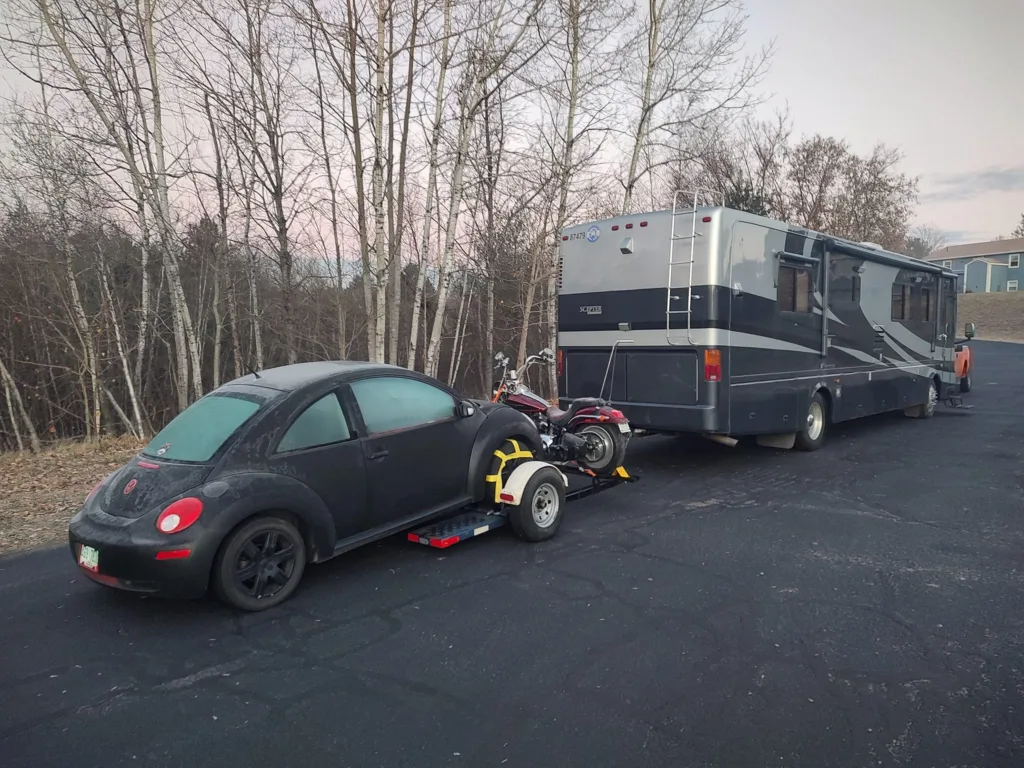
Towing a Regular Car WITH an RV
- Check your motorhome’s towing capacity: This is an essential step since all motorhomes will have a different towing capacity to handle the additional weight safely. You also need to factor in any of the weight of the vehicle, the additional weight you’re carrying in the RV or car, as this adds to the overall GVWR.
- Pick the proper towing method: There are two common methods for towing a car behind a motorhome (Neither of these is an option for an Electric or Tesla car):
- Tow bar: A tow bar connects the motorhome and the car directly, allowing all four wheels to roll on the ground. This method requires a tow bar compatible with your motorhome and car and the necessary towing accessories like safety cables and wiring connections.
- Tow dolly: Tow dollies are small trailers that carry the car’s front wheels while the back wheels remain on the ground. This method is suitable for cars that cannot be flat-towed (all four of the car’s wheels on the ground) due to their design or transmission type.
- Prepare the car for towing: Regardless of the towing method, there are a few steps to prepare the car:
- Always read the car’s owner manual: Even if you have a non-EV car, there may be specific steps for towing your vehicle. All manuals will have this information available. While it typically involves placing the vehicle into neutral on an automatic transmission or taking it out of gear on a manual transmission so the front and rear wheels spin freely, ensure there aren’t any other special needs for your vehicle.
- You may also need a supplemental braking system: Some states or provinces require a supplemental braking system on the towed vehicle. Even if it’s not mandatory, it’s generally a good idea.
- Disconnect the car battery or install a battery disconnect switch: This prevents the car’s battery from draining while being towed. If you have an electric parking brake, you may need to engage it before disconnecting the battery.
- Set up the tow bar or tow dolly: When setting up your towing system, always follow the instructions for your trailer.
- Test the setup: Before hitting the road, perform a safety check to ensure that the towed car is properly secured, the lights are working, and all connections are secure. Your trailer manual should have a checklist to perform each time you connect your car.
- Drive cautiously: Also, you need to adjust your driving style when you’re in a car. Unlike a towable RV, you may not be able to see your car from your mirrors. Take wider turns, give yourself more braking distance, and drive at or below the speed limit. Also, don’t forget about your motorhome’s increased length and weight while maneuvering and parking.
Will there be new technologies for towing Electric Vehicles in the future?
If there is one sure thing, in the coming years, Electric Vehicles will become more common. By 2040, it’s predicted that nearly all new vehicles sold in North America will be electric. As the market changes, so will technologies. Currently, the demand for towing electric vehicles is relatively low. Vehicle towing primarily exists for three purposes:
- Tow companies for breakdowns,
- Moving- people needing to tow their cars for a move,
- RVs: RVers who need to tow their vehicle behind their motorhome.
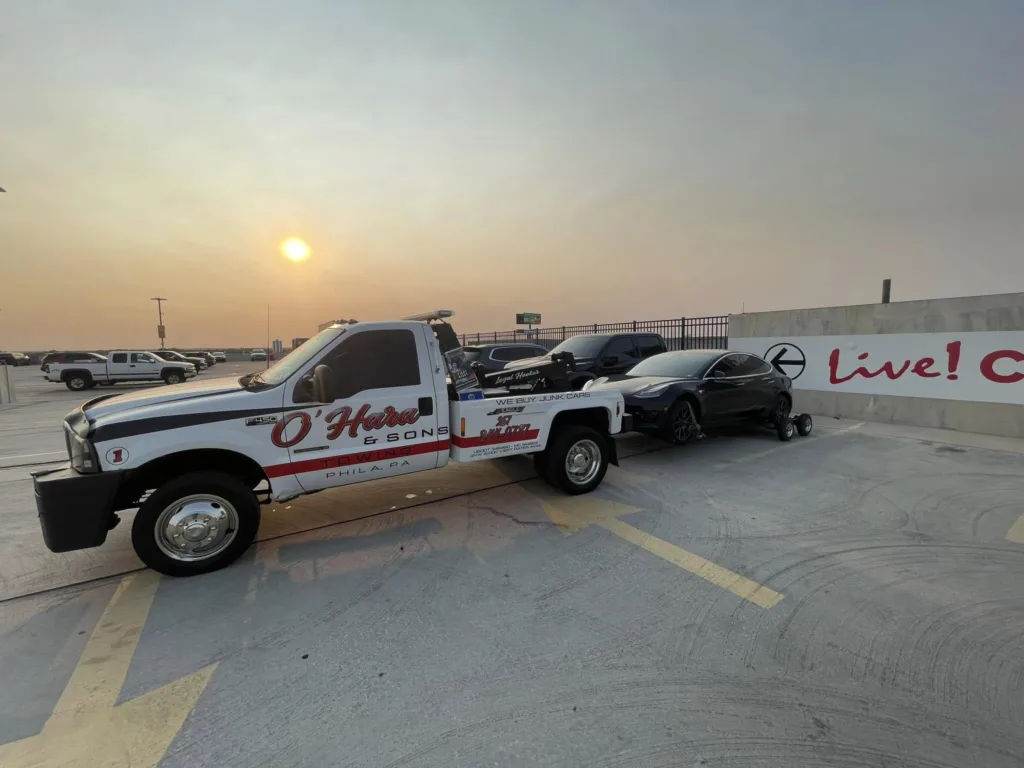
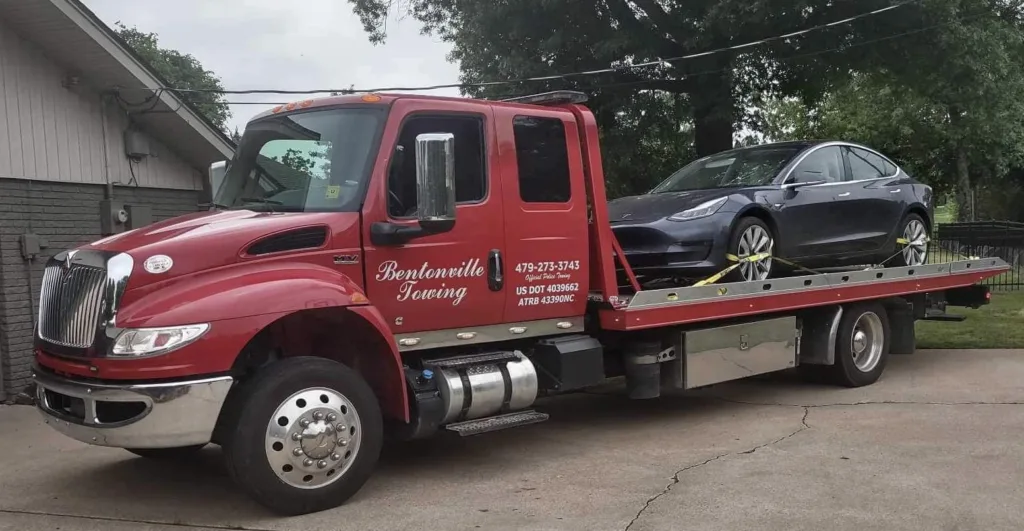
Tow companies rack up the moist miles for EV towing and use a flatbed truck or trailer. While they are generally stuck with the same limitations for transporting an RV, they have the equipment to make this feasible when you get stuck on the side of the road. In addition to the flatbed tow truck option, they may use rear-wheel dollies to move electric vehicles short distances. The other frequent towers of EVs are people moving. People who are moving long distances typically rent a truck with a flatbed trailer. These are easily accessible from moving companies like U-Haul. This leaves RVers with a potential need to tow an electric vehicle like a Tesla. While you are likely reading this article because you have this need, it’s still a small part of the market. This is why I don’t think we see many alternative towing options or design changes from EV manufacturers. The need is still relatively small, and there are available options on the road today.
However, I think in the nearer future, this will change. As more and more electric vehicles fill the roadways, more of them will need to be towed. By 2030, it’s predicted that over half of all new vehicles sold in the U.S. will be electric. As we move closer to this point, we may see two things emerge: 1) lighter-weight trailers or modular designs designed to keep EV wheels from spinning. 2) We may see manufacturers begin to develop alternate designs that allow vehicles to be safely put in transport (tow) mode, where wheels can spin when not powered by the motors. So, as the market share of electric vehicles increases, so will the demand for options for towing.
Can you tow any other EV Cars with a tow dolly?
The move in the EV market to power the vehicles via rear-wheel drive. This means many available electric cars you can buy today must have four-wheel off the ground when towing. However, some front-wheel drive electric cars may be able to be towed using a tow dolly, where just the front wheels are off the ground. This is the same for ICE rear-wheel drive vehicles. Some of these options include the Nissan Leaf and Chevrolet Bolt. However, they neither can be flat towed. Typically, whatever drive train your vehicle has, spinning wheels on the powered axles can damage your vehicle’s vital components like the motor, braking system, or cooling system, especially at high speeds.
Conclusion
If you own a Tesla or another EV car that’s all or rear-wheel drive, the only way to tow it is using a flatbed trailer. Doing otherwise can cause damage to your expensive vehicle. Currently, there aren’t any other viable ways to take your Teslas on a road trip pulled by your RV. Hopefully, there will be different ways to accomplish this in the future. However, Teslas are some of the best cars on the market today, and understandably, you may want to bring them along on your RV adventures. Just be sure to do it safely for both you and your car.
